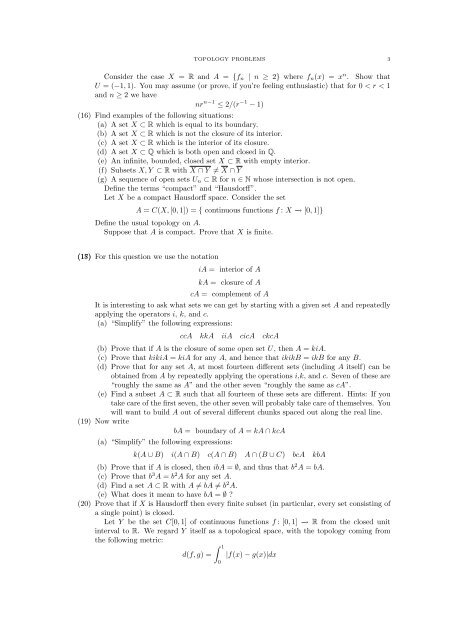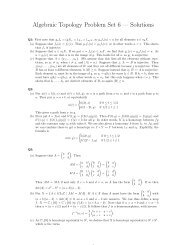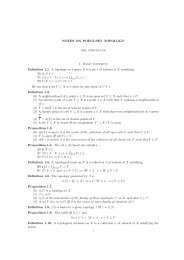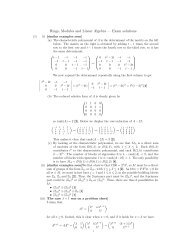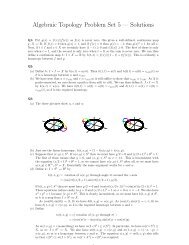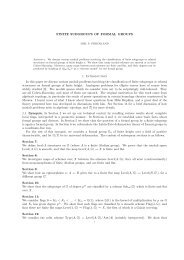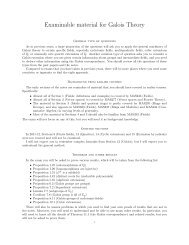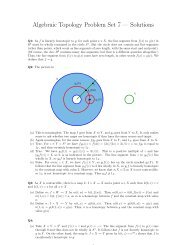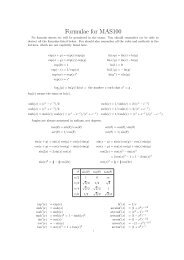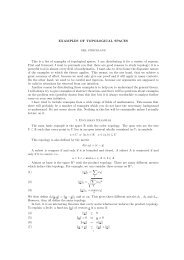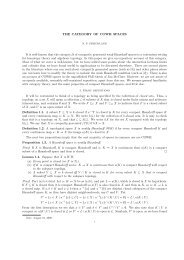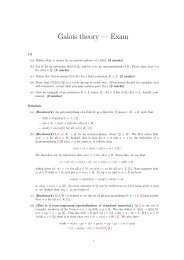TOPOLOGY PROBLEMS (1) State the Arzela-Ascoli ... - Neil Strickland
TOPOLOGY PROBLEMS (1) State the Arzela-Ascoli ... - Neil Strickland
TOPOLOGY PROBLEMS (1) State the Arzela-Ascoli ... - Neil Strickland
You also want an ePaper? Increase the reach of your titles
YUMPU automatically turns print PDFs into web optimized ePapers that Google loves.
<strong>TOPOLOGY</strong> <strong>PROBLEMS</strong> 3<br />
Consider <strong>the</strong> case X = R and A = {f n | n ≥ 2} where f n (x) = x n . Show that<br />
U = (−1, 1). You may assume (or prove, if you’re feeling enthusiastic) that for 0 < r < 1<br />
and n ≥ 2 we have<br />
nr n−1 ≤ 2/(r −1 − 1)<br />
(16) Find examples of <strong>the</strong> following situations:<br />
(a) A set X ⊂ R which is equal to its boundary.<br />
(b) A set X ⊂ R which is not <strong>the</strong> closure of its interior.<br />
(c) A set X ⊂ R which is <strong>the</strong> interior of its closure.<br />
(d) A set X ⊂ Q which is both open and closed in Q.<br />
(e) An infinite, bounded, closed set X ⊂ R with empty interior.<br />
(f) Subsets X, Y ⊂ R with X ∩ Y ≠ X ∩ Y<br />
(g) A sequence of open sets U n ⊂ R for n ∈ N whose intersection is not open.<br />
Define <strong>the</strong> terms “compact” and “Hausdorff”.<br />
Let X be a compact Hausdorff space. Consider <strong>the</strong> set<br />
A = C(X, [0, 1]) = { continuous functions f : X −→ [0, 1]}<br />
Define <strong>the</strong> usual topology on A.<br />
Suppose that A is compact. Prove that X is finite.<br />
(17) (18) For this question we use <strong>the</strong> notation<br />
iA = interior of A<br />
kA = closure of A<br />
cA = complement of A<br />
It is interesting to ask what sets we can get by starting with a given set A and repeatedly<br />
applying <strong>the</strong> operators i, k, and c.<br />
(a) “Simplify” <strong>the</strong> following expressions:<br />
ccA kkA iiA cicA ckcA<br />
(b) Prove that if A is <strong>the</strong> closure of some open set U, <strong>the</strong>n A = kiA.<br />
(c) Prove that kikiA = kiA for any A, and hence that ikikB = ikB for any B.<br />
(d) Prove that for any set A, at most fourteen different sets (including A itself) can be<br />
obtained from A by repeatedly applying <strong>the</strong> operations i,k, and c. Seven of <strong>the</strong>se are<br />
“roughly <strong>the</strong> same as A” and <strong>the</strong> o<strong>the</strong>r seven “roughly <strong>the</strong> same as cA”.<br />
(e) Find a subset A ⊂ R such that all fourteen of <strong>the</strong>se sets are different. Hints: If you<br />
take care of <strong>the</strong> first seven, <strong>the</strong> o<strong>the</strong>r seven will probably take care of <strong>the</strong>mselves. You<br />
will want to build A out of several different chunks spaced out along <strong>the</strong> real line.<br />
(19) Now write<br />
bA = boundary of A = kA ∩ kcA<br />
(a) “Simplify” <strong>the</strong> following expressions:<br />
k(A ∪ B) i(A ∩ B) c(A ∩ B) A ∩ (B ∪ C) bcA kbA<br />
(b) Prove that if A is closed, <strong>the</strong>n ibA = ∅, and thus that b 2 A = bA.<br />
(c) Prove that b 3 A = b 2 A for any set A.<br />
(d) Find a set A ⊂ R with A ≠ bA ≠ b 2 A.<br />
(e) What does it mean to have bA = ∅ ?<br />
(20) Prove that if X is Hausdorff <strong>the</strong>n every finite subset (in particular, every set consisting of<br />
a single point) is closed.<br />
Let Y be <strong>the</strong> set C[0, 1] of continuous functions f : [0, 1] −→ R from <strong>the</strong> closed unit<br />
interval to R. We regard Y itself as a topological space, with <strong>the</strong> topology coming from<br />
<strong>the</strong> following metric:<br />
d(f, g) =<br />
∫ 1<br />
0<br />
|f(x) − g(x)|dx


